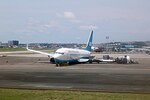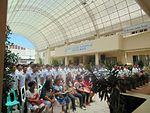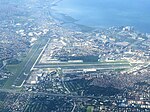Ninoy Aquino International Airport (NAIA , locally ; Filipino: Paliparang Pandaigdig ng Ninoy Aquino; IATA: MNL, ICAO: RPLL), originally known as Manila International Airport (MIA), is the main international airport serving the city of Manila and the metropolitan area of the same name. Located between the cities of Pasay and Parañaque, about 7 kilometers (4.3 mi) south of Manila proper and southwest of Makati, NAIA is the main gateway for travelers to the Philippines and serves as a hub for AirSWIFT, Cebgo, Cebu Pacific, PAL Express, and Philippine Airlines; it is also the main operating base for Philippines AirAsia. Named after Senator Ninoy Aquino (1932–1983), who was assassinated at the airport on August 21, 1983, it is managed by the Manila International Airport Authority (MIAA), an agency of the Department of Transportation (DOTr).Officially, NAIA is the only airport serving the Metro Manila area. However, in practice, both NAIA and Clark International Airport, located in the Clark Freeport Zone in Pampanga, serve the metropolis. However, Clark caters mostly to low-cost carriers because of its lower landing fees compared to the higher fees at NAIA. Recently, there have been calls for Clark to replace NAIA eventually as the primary airport of the Philippines. In an effort to reduce congestion at the airport, two new airports are being constructed: New Manila International Airport, located in Bulacan, and Sangley Point Airport, located on reclaimed land in Cavite City.Currently, NAIA is operating beyond its designed capacity of 35 million passengers, causing air traffic congestion and flight delays. The airport has been tagged by The Guide to Sleeping In Airports, luggage storage app Bounce, and travel blog Hawaiian Islands as one of the worst airports in both Asia-Pacific, if not the world. Since 2018, plans to privatize and improve the airport have been pitched, and were revived again in 2023 following a major malfunction in the airport's air traffic control system.










